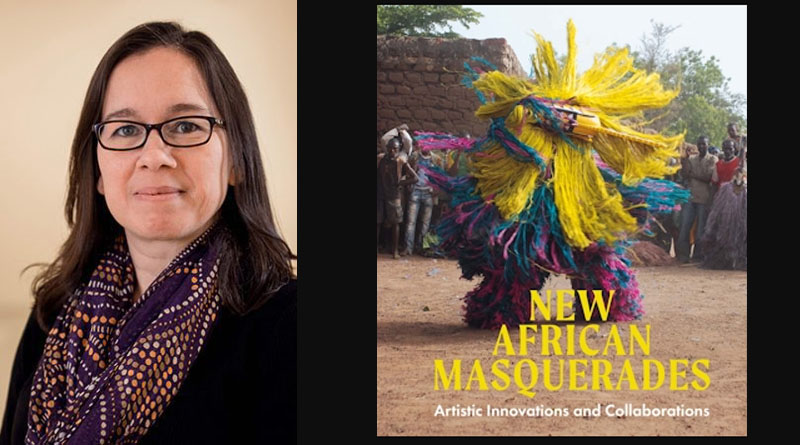Charlotte Professor Lisa Homann Curates “New African Masquerades: Artistic Innovations and Collaborations”
A decade after his death, the legacy of West African masquerade artist André Sanou is getting the international recognition it deserves and that Sanou himself hoped for.
Co-curated by Associate Professor of Art History Lisa Homann, the exhibition New African Masquerades: Artistic Innovations and Collaborations opened at the New Orleans Museum of Art on April 4 and will travel to four other venues across the country over the next two years. The exhibition includes 13head-to-toe masquerade ensembles featuring the work of four contemporary African artists: Chief Ekpenyong Bassey Nsa, Sheku “Goldenfinger” Fofanah, Hervé Youmbi, and David Sanou, who is André Sanou’s son. It is through David that André’s artistry lives on.
David Sanou lives and works in the West African country of Burkina Faso, where Homann has been conducting research since 2006. In 2008, she met the renowned masquerade sculptor André Sanou, who handed his studio over to his son David when he retired in 2009.
“During one of our conversations, André asked if I might be able to find him venues to show his work in the U.S.,” Homann wrote for the exhibition catalogue, which she co-edited with Amanda M. Maples, Françoise Billion Richardson Curator of African Art at New Orleans Museum of Art, and Jordan A. Fenton, associate professor of art history at Miami University, Ohio.
Homann was completing a scholarly article about André’s work when the elder sculptor passed away. She traveled to Burkina Faso and was able to attend his wake and funeral and begin to cultivate a deeper relationship with David. In 2018, they began to discuss commissions for museums in the United States.
“My goal was to ethically commission and acquire the works in a manner that respected and benefitted their creators, masquerade authorities, patrons, and researcher, while minimizing negative effects,” Homann wrote in the catalogue.
Between 2019 and 2022, Homann worked with David Sanou, his family, a blacksmith, another maker, several chiefs, colleagues, and friends to commission four full-body daytime masquerade ensembles. During one of their many conversations, Sanou told Homann, “I want people to know that dad himself wanted to do this during his lifetime but well…God has changed things. [Dad] couldn’t do it, but it was his will.”
In 2020, Homann and project partners Maples and Fenton received a planning grant from the National Endowment for the Humanities, which was followed by a $500,000 implementation grant in 2023. The funding allowed them to create the exhibition and catalogue, carried out in collaboration with Aimé Kantoussan, Research Director at the Musée des Civilisations Noires/Museum of Black Civilizations in Dakar, Senegal, and Hervé Youmbi, a leading contemporary artist in Cameroon.
From New Orleans, New African Masquerades will travel to Nashville, San Antonio, St. Peterburg, and Washington, D.C. Organized in partnership with the Musée des Civilisations Noires, the exhibition will also be presented in a parallel form for African audiences—the first time an exhibition will be presented in such a way in North America and Africa.
New African Masquerades: Artistic Innovations and Collaborations presents contemporary West African masquerade from the countries of Burkina Faso, Cameroon, Nigeria, and Sierra Leone.
Masquerade can be defined “as a broad set of practices wherein individuals and societies dance in full-body, multimedia ensembles,” explains the NOMA exhibition press release. “These ensembles are then activated in many ways, including in performances, processions, and other ceremonies by either the masquerade artist or another practitioner.”
Like his father, Sanou carves elaborate headpieces for ensembles that are then completed by another artist, who, in keeping with cultural practice and his wishes, remains anonymous. While it is unprecedented for these ensembles to appear in a museum setting, Homann made sure that the presentation was true to its social and performative contexts.
“I had sent to the staff photos of similar masks in action so they could create a natural pose for the ensemble,” she said, describing the “Compromise Kimi” masquerade ensemble. “It looks like it had just stopped in its tracks. With its body slightly hunched, its left leg forward, arms swung out, and head jutting out toward the viewer, it seems alert and a little intimidating. But that hunched, almost squatting position is also how masks greet people.”
Homann said that Sanou, who attended the exhibition opening, was thrilled with the installation of the ensemble and “fondly stared at it often.”
In addition to the 13 masquerade ensembles, the exhibition includes photography, recorded interviews, and immersive videos that demonstrate the ensembles being performed, looks into the artists’ studios, and shares the perspectives of the artists.
The video Homann produced for the exhibition touched Sanou “to the point of tears,” she said. “He and I had many conversations over the years about why he agreed to the commissions and the show, neither of which have ever been done before with the legitimate consent of masquerade authorities. He did it to honor his deceased father, André Sanou, and his legacy. I think it is a deeply satisfying accomplishment for him. It is for me.”
**********************************************
Exhibition Travel Schedule and Presentation in Africa
- April 4–August 10, 2025: New Orleans Museum of Art
- October 10, 2025–January 4, 2026: Frist Art Museum, Nashville
- February 27-July 5, 2026: San Antonio Museum of Art
- September 2026–January 2027: Museum of Fine Arts, St. Petersburg, Florida
- February 19–September 26, 2027: National Museum of African Art, Smithsonian Institution, Washington, DC
The exhibition will also be presented in a parallel form for African audiences. The presentation of New African Masquerades at these African venues will include newly commissioned masquerade ensembles that will remain in the care of communities and institutions on the continent.
- February–June 2026: Musée des Civilisations noires, Dakar, Senegal
- Fall 2026: Sierra Leone National Museum, Freetown, Sierra Leone
- 2027: National Museum, Calabar, Nigeria.

